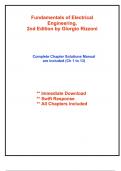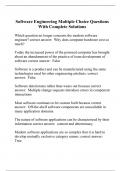Fundamentals of Electrical
Engineering,
2nd Edition by Giorgio Rizzoni
Complete Chapter Solutions Manual
are included (Ch 1 to 13)
** Immediate Download
** Swift Response
** All Chapters included
,Rizzoni and Kearns, Fundamentals of Electrical Engineering, 2 nd Edition Problem solutions, Chapter 1
Chapter 1: Fundamentals of Electrical Circuits – Instructor Notes
Chapter 1 develops the foundations for the first part of the book. Coverage of the entire
chapter would be typical in an introductory course. The first four sections provide the basic
definitions (Section 1.1) and cover Kirchhoff’s Laws, instantaneous power and the passive sign
convention (Sections 1.2, 1.3 and 1.4); A special feature, Focus on Problem Solving: The
Passive Sign Convention (p. 22) and ten examples illustrate these important topics. A second
feature, that will recur throughout the first six chapters, is presented in the form of sidebars.
Make The Connection: Hydraulic Analog of a Voltage Source (p. 28) and Make The Connection:
Hydraulic Analog of a Current Source (p. 29) present the concept of analogies between
electrical and other physical domains.
Sections 1.5 and 1.6 introduce the i-v characteristic and the resistance element. Tables
1.1 (p. 31) and 1.2 and 1.3 (p. 33) summarize the resistance of copper wire for various gauges,
the resistivity of common materials and standard resistor values, respectively. The sidebar
Make The Connection: Hydraulic Analog of Electrical Resistance (p. 31) continues the electric-
hydraulic system analogy.
Sections 1.7 and 1.8 introduce the critically important concepts of elements in series and
parallel and the associated analytic methods of voltage and current division. Section 1.8
introduces another special feature of the book, the Focus on Measurements box. The first
three of these boxes appear at the end of that section and are focused on practical aspects of a
Resistive Throttle Position Sensor, Resistance Strain Gauges, and The Wheatstone Bridge and
Force Measurements. These three boxes demonstrate the common role of voltage division in
the construction of electrical sensors.
Finally, Sections 1.9 and 1.10 introduce basic but important concepts related to ideal
and non-ideal models of practical sources, and common measuring instruments.
The Instructor will find that although the material in Chapter 1 is quite basic, it is possible
to give an applied flavor to the subject matter by emphasizing a few selected topics in the
examples presented in class. In particular, a lecture could be devoted to resistance devices,
including the resistive displacement transducer of Focus on Measurements: Resistive Throttle
Position Sensor (pp. 46-47), the resistance strain gauge of Focus on Measurements:
Resistance Strain Gauges (p. 48), and Focus on Measurements: The Wheatstone Bridge and
Force Measurements (pp. 49-50). The instructor wishing to gain a more in-depth understanding
of resistance strain gauges can find detailed analyses in many common references.
Early motivation for the application of circuit analysis to problems of practical interest to
the non-electrical engineer can be found in these Focus on Measurements boxes. The
Wheatstone bridge material can also serve as an introduction to a laboratory experiment on
strain gauges and the measurement of force. Finally, Example 1.16 on the Impact of a
Practical Voltmeter at the end of Section 1.10 describes a quick but interesting laboratory
experiment.
The homework problems include a variety of practical examples, with emphasis on
instrumentation. Problem 1.39 illustrates the result of placing two practically equivalent
batteries in parallel; problems 1.43 relates to wire gauges; problem 1.44 discusses one common
method of resistor construction; problem 1.45 illustrates analysis related to fuses; problem 1.53
1.1
,Rizzoni and Kearns, Fundamentals of Electrical Engineering, 2 nd Edition Problem solutions, Chapter 1
introduces the thermistor; problem 1.54 discusses circuit design involving a moving coil meter;
problem 1.57 describes a procedure for measuring the internal resistance of an ammeter;
problem 1.60 illustrates the potential loading effect of a practical voltmeter; and problems 1.62
and 1.63 illustrate calculations related to strain gauge bridges.
It has been the author's experience that providing the students with an early introduction
to practical applications of electrical engineering to their own disciplines can increase the
interest level in a course significantly.
Learning Objectives for Chapter 1
Students will learn to…
1. Identify the principal features of electric circuits or networks: nodes, loops, meshes, and branches.
Section 1.1.
2. Apply Kirchhoff’s Laws to simple electrical circuits. Sections 1.2-1.3.
3. Apply the passive sign convention to compute the power consumed or supplied by circuit elements.
Section 1.4.
4. Identify sources and resistors and their i-υ characteristics. Sections 1.5–1.6.
5. Apply Ohm’s law and voltage and current division to calculate unknown voltages and currents in
simple series, parallel, and series-parallel circuits. Sections 1.6–1.8.
6. Understand the impact of internal resistance in practical models of voltage and current sources as
well as of voltmeters, ammeters, and wattmeters. Sections 1.9–1.10.
1.2
, Rizzoni and Kearns, Fundamentals of Electrical Engineering, 2 nd Edition Problem solutions, Chapter 1
Sections 1.2-1.3: Charge, Current, and Kirchhoff’s Current Law;
Voltage and Kirchhoff’s Voltage Law
Problem 1.1
A free electron has an initial potential energy per unit charge (voltage) of 17 kJ/C and a velocity
of 93 Mm/s. Later, its potential energy per unit charge is 6 kJ/C. Determine the change in
velocity of the electron.
Solution:
Known quantities:
m
Initial Coulombic potential energy, Vi 17kJ /C ; initial velocity, U i 93M ; final Coulombic
s
potential energy, V f 6kJ /C .
Find:
The change in velocity of the electron.
Assumptions:
PEg PEc
Analysis:
Using the first law of thermodynamics, we obtain the final velocity of the electron:
Qheat W KE PEc PEg ...
Heat is not applicable to a single particle. W=0 since no external forces are applied.
KE PEc
1
me (U 2f Ui2 ) Qe (V f Vi )
2
2Qe
U 2f U i2 (V f Vi )
me
2
93 M
m 2 1.6 10
19
C
6kV 17kV
s 9.11 10 37 g
m2 15 m
2
8.649 10 15 3.864 10
s2 s2
m
U f 6.917 10 7
s
m m m
U f U i 93 M 69.17 M 23.83 M .
s s s
1.3





